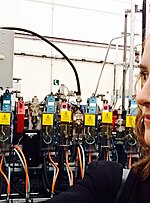Creamfields
Creamfields is an electronic dance music festival series founded and organised by British club promoter Cream, with its UK edition taking place on August Bank Holiday weekend, with a number of international editions held across various territories worldwide. First held in 1998 in Winchester, the festival moved to Cream's home city of Liverpool the following year, taking place on the old Liverpool airport, before moving to its current location on the Daresbury estate in Cheshire. The festival, having initially begun as a one-day event with 25,000 people in attendance, is now a four-day event with camping options hosting 70,000 per day. The festival is the UK's most prestigious electronic dance music festival.In 2022, Creamfields celebrated its 25th anniversary by launching a second UK-based festival – Creamfields South. Creamfields South took place at Hylands Park, Chelmsford across the Platinum Jubilee weekend in June and is scheduled to return in 2023, with the original Daresbury festival being renamed Creamfields North.
Excerpt from the Wikipedia article Creamfields (License: CC BY-SA 3.0, Authors).Creamfields
Daresbury Lane,
Geographical coordinates (GPS) Address Nearby Places Show on map
Geographical coordinates (GPS)
| Latitude | Longitude |
|---|---|
| N 53.34 ° | E -2.63 ° |
Address
Daresbury Lane
Daresbury Lane
WA4 4AE
England, United Kingdom
Open on Google Maps








